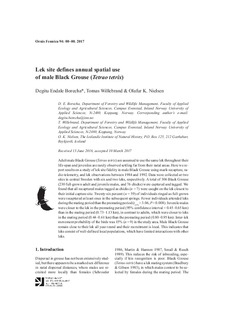| dc.contributor.author | Borecha, Degitu Endale | |
| dc.contributor.author | Willebrand, Tomas | |
| dc.contributor.author | Nielsen, Olafur K. | |
| dc.date.accessioned | 2017-07-12T07:54:49Z | |
| dc.date.available | 2017-07-12T07:54:49Z | |
| dc.date.created | 2017-03-18T08:50:53Z | |
| dc.date.issued | 2017 | |
| dc.identifier.citation | Ornis Fennica. 2017, 94 . | nb_NO |
| dc.identifier.issn | 0030-5685 | |
| dc.identifier.uri | http://hdl.handle.net/11250/2448495 | |
| dc.description.abstract | Adult male Black Grouse (
Tetrao tetrix
) are assumed to use the same lek throughout their
life-span and juveniles are rarely observed settling far from their natal areas. Here we re-
port results on a study of lek site fidelity in male Black Grouse using mark-recapture, ra-
dio-telemetry, and lek observations between 1984 and 1992. Data were collected at two
sites in central Sweden with six and two lek
s, respectively. A total of 306 Black Grouse
(230 full-grown adult and juvenile males, and 76 chicks) were captured and tagged. We
found that all recaptured males tagged as chicks (
n
= 7) were caught on the lek closest to
their initial capture site. Twenty-six percent (
n
= 59) of individuals ringed as full-grown
were recaptured at least once in the subseque
nt springs. Fewer individuals attended leks
during the mating period than the premating period (
t
(15)
= 3.06,
P
= 0.008). Juvenile males
were closer to the lek in the premating period (95% confidence interval = 0.45–0.65 km)
than in the mating period (0.73–1.13 km), in contrast to adults, which were closer to leks
in the mating period (0.44–0.61 km) than the premating period (0.80–0.95 km). Inter-lek
movement probability of the birds was 15% (
n
= 9) in the study area. Male Black Grouse
remain close to their lek all year round and their recruitment is local. This indicates that
leks consist of well-defined local populations
, which have limited interactions with other
leks. | nb_NO |
| dc.language.iso | eng | nb_NO |
| dc.title | Lek site defines annual spatial use of male Black Grouse (Tetrao tetrix) | nb_NO |
| dc.title.alternative | Orrtuppars spelplats bestämmer deras rörelsemönster | nb_NO |
| dc.type | Journal article | nb_NO |
| dc.type | Peer reviewed | nb_NO |
| dc.subject.nsi | VDP::Matematikk og Naturvitenskap: 400::Zoologiske og botaniske fag: 480 | nb_NO |
| dc.source.pagenumber | 11 | nb_NO |
| dc.source.volume | 94 | nb_NO |
| dc.source.journal | Ornis Fennica | nb_NO |
| dc.identifier.cristin | 1459153 | |
| cristin.unitcode | 209,55,2,0 | |
| cristin.unitname | Institutt for skog- og utmarksfag | |
| cristin.ispublished | false | |
| cristin.fulltext | postprint | |
| cristin.qualitycode | 1 | |
